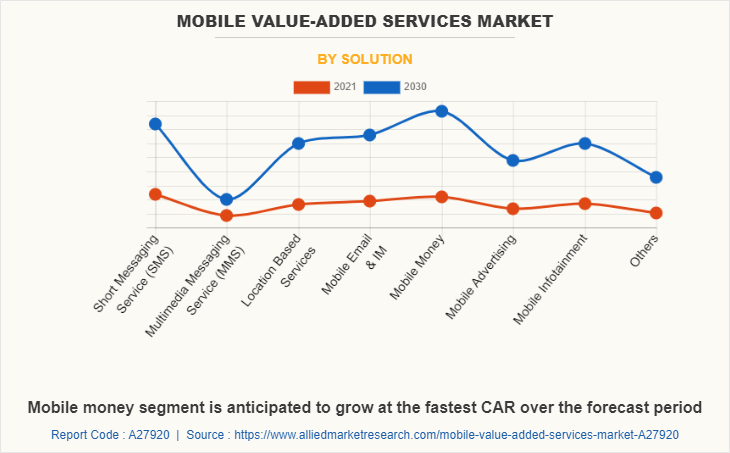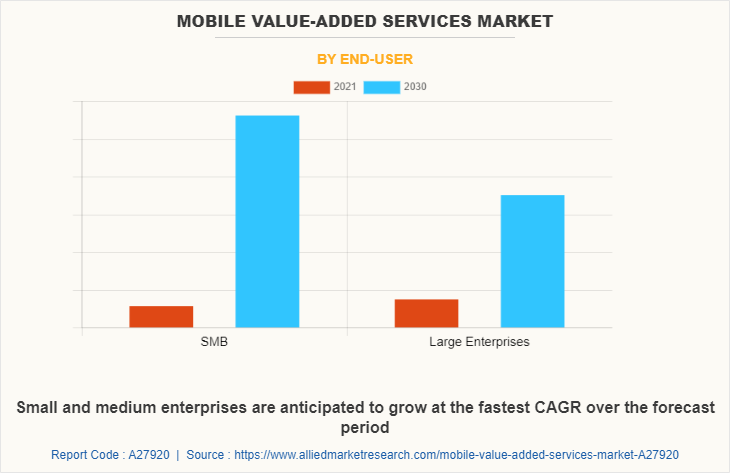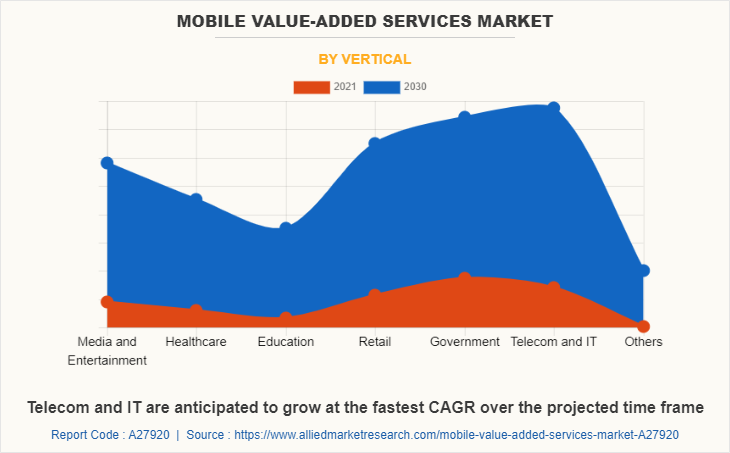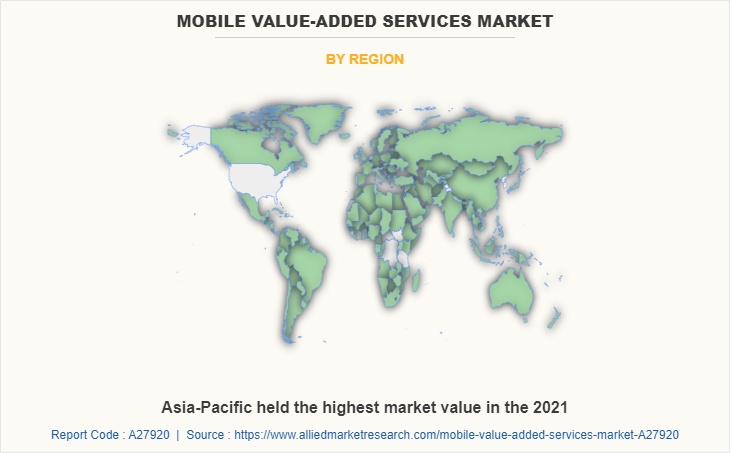Mobile Value-Added Services Market Insights, 2030
The global mobile value-added services market was valued at USD 658.5 billion in 2021 and is projected to reach USD 2,226.2 billion by 2030, growing at a CAGR of 14.2% from 2022 to 2030.
Mobile services that are provided by mobile service providers in addition to voice communication services are known as Mobile Value-added Services or MVAS. Mobile subscribers can use smartphones and tablets for a variety of non-voice purposes, thanks to the MVAS, which includes sending Short Message Service (SMS), Multimedia Messaging Service (MMS), mobile email & instant messaging, mobile money, location-based services, mobile advertising, and mobile infotainment. Mobile value-added services are marketed by telecommunication companies as premium features or supplements to their essential services. These services typically do not merely broaden the functionality of product packages. They are utilized to create administrative and operational efficiencies across a wide range of services. Additionally, they are advantageous for both service providers and clients as they increase end-user functionality while obtaining improved analytics and data for commercial usage.

The market for mobile value-added services is being driven by reasons such as an increase in the number of smartphone and tablet users, mobile Internet usage, higher use of mobile applications and mobile web, and increased return on marketing expenditure. Multiple vendors have boosted competition among Internet service providers. Nowadays, people use their smartphones to check a variety of applications, browse the web, check their emails, interact on social media, and others.
In order to improve the user experience, mobile value-added services are services that telecom service providers offer to clients in addition to voice, SMS, and data services. The prices of cell phones, smartphones, tablets, and associated goods have drastically dropped, enabling mobile value-added service companies to increase their customer base by attracting members of the middle and lower middle classes. So that the rising numbers of smartphone users are expected to generate significant market income for global mobile value-added services. These factors are anticipated to propel the mobile value-added services market growth.
The users' ability to use mobile value-added services may be limited by a lack of regulations and rules for the several market participants in MVAS. The data and information of value-added service customers must be protected in light of the rapid growth of technology and new technologies. The main issue faced by the market for mobile value-added services is a lack of privacy. The market expansion may also be constrained by a lack of government initiatives and limited capabilities of customer authentication for services involving the sharing of sensitive data, such as payments.
Due to the rapid rise of digitalization and consumer embrace of technology, there is an increasing need for smartphones. Additionally, a surge in the use of MVAS through online channels is a boon for the expansion of the mobile value-added services market and driving up demand for smartphones. This technological advancement enables the telecom industry to provide a variety of value-added services that you may market to your client base as new goods through various channels. The fifth generation, or 5G, which is still a developing technology in the global telecommunications business, is anticipated to be accompanied by technological advancements. Millions of new, safe, and quick connections are anticipated to be added with the adoption of 5G. The global mobile value-added services industry is predicted to see rising revenues as a result of the emerging 5G technology due to the rising population and demand for smartphones.
The key players profiled in this report include Mozat, Apple Inc., Vodafone Group plc, Samsung Electronics Co. Ltd., Reliance Industries Ltd., Huawei Investment & Holding Co. Ltd., Onmobile Global Limited, Comviva Technologies, Alphabet Inc., and One97 Communication.
The global mobile value-added services market is segmented on the basis of solution, end-user, vertical type, and region. By solution, the market is sub-segmented into Short Messaging Service (SMS), Multimedia Messaging Service (MMS), location-based services, mobile email & instant messaging, mobile money, mobile advertising, and mobile infotainment. By end-user, the market is classified into small & medium enterprises and large enterprises. By vertical type, the market is classified into media & entertainment, healthcare, education, retail, government, telecom & IT, and others. By region, the market is analyzed across North America, Europe, Asia-Pacific, and LAMEA.
By solution, the Short Messaging Service (SMS) sub-segment dominated the market in 2021. The communications that people send from their mobile phones are known as text messages or short messaging service messages. Short messaging is becoming a more popular e-marketing channel since it makes it easy to send information to large groups of people rapidly and conveniently. More importantly, SMS messaging has higher user engagement than other mobile marketing channels such as email or social media. These are predicted to be the major factors affecting the mobile value-added services market demand during the forecast period too.

By solution, the mobile money sub-segment witnessed the fastest market growth in 2021. By using the mobile money service, different financial services can be offered to mobile subscribers such as mobile banking, mobile ticketing, mobile wallet, mobile coupons, and mobile money transfer. Mobile banking uses the mobile money service to enable various banks and financial institutions to offer their customers rich value-added services such as accessing account information, transferring money, and paying bills.
The subscribers get a banking alert when they make any transactions. These are predicted to be the major factors affecting the mobile value-added services market size during the projection period.
By end-user, the large enterprises sub-segment dominated the market in 2021. The mobile value-added services demand in large enterprises is rising rapidly as the penetration of mobile phone users is increasing around the globe. Large enterprises are using mobile value-added services as a way to reach customers who were previously out of reach because of a lack of physical infrastructure and high expense of providing services in remote places. Additionally, there is a rising demand from large enterprises such as banks, healthcare providers, electronic consumer goods manufacturers, and others to use mobile applications and other value-added services as a channel to give their customers easy access to services as well as increase productivity and efficiency. These are predicted to be the major factors affecting the mobile value-added services market size during the forecast period too.

By vertical type, the government sub-segment dominated the market in 2021. The expansion of Internet services and enhanced SMS services are expected to drive the MVAS industry in the coming years. For instance, in India, the government and telecom companies are investing in enhancing infrastructural connectivity in rural areas so that they can provide their services such as selling and procurement information and support for farm commodities, educating farming community on best practices, delivery of healthcare and education to remote village via the mobile broad band network, easy access to services such as government services, and other services to provide in rural as well as in semi urban areas. These are predicted to be the major factors affecting the mobile value-added services market size during the forecast period.

By region, Asia-Pacific dominated the global market in 2021 and is projected to remain the fastest-growing sub-segment during the forecast period. The number of mobile phone users in Asia-Pacific region is high and mobile phones are majorly used for various entertainment purpose such as news, mobile banking, movies, and others. The market is expected to grow at a rapid rate due to factors including rising number of businesses and industry verticals using various mobile value-added services and the booming retail, e-commerce, and IT and telecommunications sectors in the region.
The mobile value-added services market share in the region is driven by factors including the existence of numerous mobile value-added services providers offering services to organizations and vertical markets and advancements in value-added services technology. The region’s mobile value-added services market is witnessing significant structural changes and is anticipated to expand and generate more income. Next-generation networks are expected to soon be made available soon. In the Asia-Pacific region, particularly in India and China telecommunications industry is growing at a rapid rate. These networks should improve the standard of services provided to clients and customers. These factors are anticipated to improve the overall growth of mobile value-added services in the Asia-Pacific region in the projected timeframe.

Impact of COVID-19 on the Industry
- COVID-19 impact on the mobile value-added services market is positive during the pandemic. For example, stay-at-home orders have made many people aware of applications that allow them to purchase groceries online, and when they do go to the shop, more people are opting to pay with their phones rather than using cash or credit cards.
- Digital communications infrastructure is being efficiently provided to governments and health authorities by business entities around the world. The MVAS messaging ecosystem enables citizens to use various mobile channels to book appointments for COVID-19 tests and other services, and it empowers healthcare practitioners to send out real-time public health notifications.
- However, during the COVID-19 pandemic the mobile value-added services were used for providing various services by a financial institution, government, education system, and healthcare services providers such as providing mobile-health facilities to people who were suffering from COVID-19 and other such services
Key Benefits For Stakeholders
- This report provides a quantitative analysis of the market segments, current trends, estimations, and dynamics of the mobile value-added services market analysis from 2021 to 2030 to identify the prevailing mobile value-added services market opportunities.
- The mobile value-added services market forecast research is offered along with information related to key drivers, restraints, and opportunities.
- Porter's five forces analysis highlights the potency of buyers and suppliers to enable stakeholders to make profit-oriented business decisions and strengthen their supplier-buyer network.
- In-depth analysis of the mobile value-added services market segmentation assists to determine the prevailing market opportunities.
- Major countries in each region are mapped according to their revenue contribution to the global market.
- Market player positioning facilitates benchmarking and provides a clear understanding of the present position of the market players.
- The report includes the analysis of the regional as well as global mobile value-added services market trends, key players, market segments, application areas, and market growth strategies.
Mobile Value-Added Services Market Report Highlights
| Aspects | Details |
| Market Size By 2030 | USD 2226.2 billion |
| Growth Rate | CAGR of 14.2% |
| Forecast period | 2021 - 2030 |
| Report Pages | 320 |
| By Vertical |
|
| By Solution |
|
| By End-User |
|
| By Region |
|
| Key Market Players | Apple Inc., Alphabet Inc., OnMobile Global Limited, Samsung Electronics Co. Ltd., Reliance Industries Ltd., Huawei Investment & Holding Co. Ltd., Mozat Pte Ltd, Comviva Technologies, Vodafone Group plc, One97 Communications |
Analyst Review
An increase in demand for mobile value-added services applications by government and enterprises to provide various value-added services such as mobile money, mobile health, mobile education, and others is the key factor that is projected to drive the growth of the global mobile value-added services market during the forecast period. In addition, the rising penetration of mobile phones and advancements in telecommunication technology such as the introduction of 4G and 5G services in the telecom market is going to play a significant role in providing new value-added services to customers. However, the lack of government rules and regulations regarding data, information, and network security are the key factors expected to hamper the market growth during the forecast period. On the contrary, the rapid growth of mobile applications and their use by mobile phone users for entertainment, gaming, money transfer, ticket booking, and other services are anticipated to provide remunerative opportunities for key players to maintain the pace of the mobile value-added services market in the upcoming years.
Among the analyzed regions, Asia-Pacific is expected to account for the highest revenue in the market by the end of 2031, followed by Europe, North America, and LAMEA. The rapid use of smartphones and increasing telecommunication infrastructure in various nations such as China and India is responsible for the leading position of Asia-Pacific in the global mobile phone value-added services market.
The global mobile value-added services market was valued at USD 658.5 billion in 2021 and is projected to reach USD 2,226.2 billion by 2030
The global mobile value-added services market is projected to grow at a compound annual growth rate of 14.2% from 2022 to 2030 to reach USD 2,226.2 billion by 2030
Mozat, Apple Inc., Vodafone Group plc, Samsung Electronics Co. Ltd., Reliance Industries Ltd., Huawei Investment & Holding Co. Ltd., Onmobile Global Limited, Comviva Technologies, Alphabet Inc., and One97 Communication are the major players in the mobile value-added services market.
Asia-Pacific will provide more business opportunities for the global mobile value-added services market in future.
The diverse applications of mobile value-added services across entertainment, education, medical care, and other sectors is the major market driver. In addition, increase in use of mobile applications and advancements in technology is going to generate excellent opportunities in the mobile value-added services market.
Loading Table Of Content...



